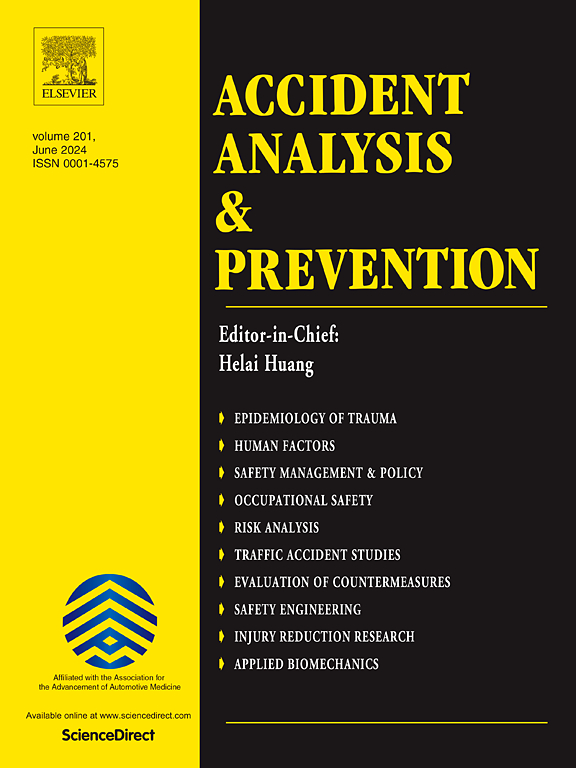Understanding e-scooter rider crash severity using a built environment typology: A two-stage clustering and random parameter model analysis
IF 5.7
1区 工程技术
Q1 ERGONOMICS
引用次数: 0
Abstract
E-scooters are an emerging transport mode that is transforming urban mobility; however, their proliferation has raised concerns about safety. This study combines UK e-scooter crash data with built environment characteristics from the crash locations. A two-stage framework was followed: first, a typology of built environments was developed using K-means++; second, crash severity within each cluster was analysed using a random parameter binary logit model. Four built environment clusters were identified: (1) car-centric and mixed-use zones, (2) commercial and industrial zones, (3) intersection-dense areas, and (4) residential and central areas. Collisions with motor vehicles, younger e-scooter riders, and higher speed limits were the most common risk factors across the clusters, with the first two clusters showing a higher impact of these factors on the likelihood of severe crashes. In the first and second clusters, riding on the carriageway significantly increased injury severity. In the second cluster, three collision types were significant, more than in other clusters where only side-impact collisions were significant. This indicates high e-scooter–motor vehicle friction in the second cluster. Among all collision types, head-on collisions increased the likelihood of severe outcomes more than others. In the third and fourth clusters, peak hours were associated with a lower likelihood of severe crashes, while this variable showed the opposite impact in the first cluster. The results highlight that consideration of the surrounding built environment is paramount when analysing e-scooter crash severity, as unique contributing factors were identified specific to each built environment type, along with varying magnitudes or directions of marginal effects.
利用建筑环境类型学理解电动滑板车骑手碰撞严重程度:两阶段聚类和随机参数模型分析
电动滑板车是一种新兴的交通方式,正在改变城市交通;然而,它们的扩散引发了人们对安全的担忧。本研究将英国电动滑板车碰撞数据与碰撞地点的建筑环境特征相结合。遵循两个阶段的框架:首先,使用k -means++开发建筑环境的类型学;其次,使用随机参数二元logit模型分析每个集群内的崩溃严重程度。研究确定了四个建筑环境集群:(1)以汽车为中心和混合功能区;(2)商业和工业区;(3)十字路口密集区;(4)居住区和中心区。与机动车辆、年轻的电动摩托车骑手和更高的速度限制的碰撞是整个集群中最常见的风险因素,前两个集群显示出这些因素对严重碰撞可能性的影响更高。在第一组和第二组中,在行车道上骑行明显增加了受伤的严重程度。在第二个集群中,三种碰撞类型是显著的,而在其他集群中,只有侧面碰撞是显著的。这表明在第二集群中,电动滑板车与机动车的摩擦很大。在所有碰撞类型中,正面碰撞比其他碰撞更有可能增加严重后果。在第三和第四个集群中,高峰时间与较低的严重碰撞可能性相关,而该变量在第一个集群中显示相反的影响。研究结果强调,在分析电动滑板车碰撞严重程度时,考虑周围的建筑环境是至关重要的,因为每种建筑环境类型都确定了独特的影响因素,以及不同程度或方向的边际效应。
本文章由计算机程序翻译,如有差异,请以英文原文为准。
求助全文
约1分钟内获得全文
求助全文
来源期刊

Accident; analysis and prevention
Multiple-
CiteScore
11.90
自引率
16.90%
发文量
264
审稿时长
48 days
期刊介绍:
Accident Analysis & Prevention provides wide coverage of the general areas relating to accidental injury and damage, including the pre-injury and immediate post-injury phases. Published papers deal with medical, legal, economic, educational, behavioral, theoretical or empirical aspects of transportation accidents, as well as with accidents at other sites. Selected topics within the scope of the Journal may include: studies of human, environmental and vehicular factors influencing the occurrence, type and severity of accidents and injury; the design, implementation and evaluation of countermeasures; biomechanics of impact and human tolerance limits to injury; modelling and statistical analysis of accident data; policy, planning and decision-making in safety.
 求助内容:
求助内容: 应助结果提醒方式:
应助结果提醒方式:


